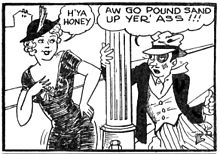Tijuana Bible
Tijuana Bibles , also known as eight-pagers or bluesies , are pornographic comics that primarily circulated in the United States from the 1920s to 1960s . The term eight-pagers refers to what is usually eight pages, with each page corresponding to a single image. The attribution to the Mexican border town of Tijuana , from which many disreputable smuggled goods came, also comes from this time; most of the booklets were made in the USA. The small-format (approx. 5 × 10 cm) booklets, printed on cheap paper, contained pornographic picture stories, often starring well-known comic characters or actors . They are considered the forerunners of the underground comix of the 1960s.
Eight-pagers' illustrators always remained anonymous, even if some published under a constant pseudonym . The quality and style of the drawings vary - from the crudest amateur drawings to well-made strips that can only come from professional graphic artists. Some of this underground porn is thought to be well-known comic artists; others are probably just from less talented, but enterprising, casual artists who had access to a printing press . Commercial artist and comic artist Wesley Morse ( Bazooka Joe ) is one of the few authors known by name. Around 60 Tijuana Bibles come from Morse, including one of the most famous strips that is set at the 1939 World's Fair in New York City : a couple has sex on a trolley while they tour attraction after attraction.
The main characters in the stories are comic heroes and heroines such as Popeye , Tarzan , Donald Duck , Betty Boop , Dagwood and Blondie , Little Orphan Annie and Wonder Woman , movie stars such as James Cagney , Mae West , Ingrid Bergman , Laurel and Hardy or the Marx Brothers , well-known Personalities like Joe Louis , Al Capone , Mussolini , or simply housewives, agents, firefighters and hotel boys. Each plot tells a short story that quickly leads to one (or more) explicit sexual act (s).
Tijuana Bibles is dominated by a pleasurable, positive portrayal of heterosexuality . Women appear in them with the same sexual energy, sensation of pleasure and initiative as men. Vaginal intercourse , cunnilingus and fellatio , female masturbation , lesbian sex and threesomes are among the most popular sexual practices shown , with the positions varying from picture to picture as much as possible. The story is always provided with pornographic, often funny dialogues in speech bubbles or narrative subtitles. The stories often have comical, parodistic or grotesque traits, so that many picture stories not only serve the pure representation of sexual acts, but also offer entertainment value as a tongue-in-cheek satire . While many eight-pagers limit themselves to the simple depiction of nudity and genitals, there are also those who skillfully parody their “role models” and have created their own burlesque art form with language and narrative style.
Tijuana Bibles were as Bob Adelman writes in the Prohibition era was born, matured to manhood in the Great Depression of the late 1920s and 1930s and eventually died in the 1960s. Since their distribution was illegal, they were sold under the counter and often circulated from reader to reader. The exact edition is unknown, but millions of these booklets were probably in circulation, especially since pirated prints were very easy to produce. From the mid-1930s, booklets that had 16, 24 or even 32 pages or were more elaborately produced came into circulation. After the Second World War, interest declined with the emergence of the first erotic men's magazines such as Playboy , which appeared from 1953 and which eventually pushed the eight-pagers off the market. For some time the booklets were now sold legally and offered in classifieds as mail order items, but the range of erotic and satire in ordinary comics and magazines grew. The drawing style and the linguistic, cheeky humor of Tijuana Bibles lived on in the underground comix , whose heyday began in the 1960s. It was during this time that the first reprints and graphic homages appeared . Today, Tijuana Bibles are an expensive collector's item, depending on their state of preservation and authenticity.
literature
- Dominik M. Klinger (Ed.): Erotic comic art. Palast Verlag, Paderborn 2007, ISBN 978-3-939527-04-6 (reprint of many eight-pagers with a foreword by the editor)
- Dominik M. Klinger: The early days of erotic comics: 1900-1935. Early erotic comics . DMK-Verlag, Nuremberg 1985, limited edition of 2000 pieces (numbered), ISBN 3-923642-50-4
- Bob Adelman: Tijuana Bibles: Art and Wit in America's Forbidden Funnies, 1930s-1950s. Simon & Schuster, New York 1997, ISBN 0684834618 (reprint of many eight-pagers with a foreword by Art Spiegelman )
- Sex in Comics - Die Geschichte der Eight Pagers , Edition in German (1985), without publisher's information, ISBN and author (reprint with German texts, hand-lettered)
